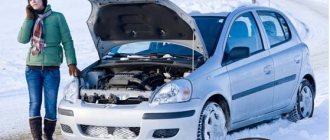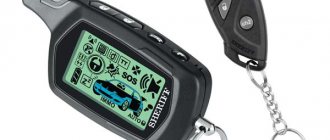We live in a northern country and even in the middle zone it is frosty from October to March. Cold weather brings many problems, including increased fuel consumption.
In the north there is a whole school of survival and using a car in the cold. For example, double glazing - ordinary glass cannot be warmed up in severe frosts; it freezes. If there is no warm garage, then in some regions drivers do not turn off the engine at all: they started it in the fall and turned it off in the spring.
But even in the middle zone, the car has a very good appetite in the cold. Why does fuel consumption increase in winter?
Warming up the engine
The instructions for modern cars say directly: warming up is not needed. However, this point was made to please environmentalists and professional motorists do not agree with it. Fuel consumption when warming up the engine in winter drains the tank faster than usual, but repairs will cost more. In cold weather, the oil thickens and its lubricating properties are lost. When the engine is cold, it works under load and wears out more. It is better to choose a middle ground: let the engine warm up slightly and only then hit the road. At low temperatures this will take about three minutes; as the temperature drops, the warm-up time increases.
Warming up helps get rid of foggy windows that are unsafe to drive with.
Increased fuel consumption in winter has been studied repeatedly and experiments have been carried out. The option with prolonged engine warm-up definitely loses. Options with short-term engine idling and without it at all are virtually equivalent from the point of view of fuel economy: during a cold start, the engine runs on a rich mixture and still part of the fuel does not burn out completely.
Therefore, the only economical and safe option for the engine is to warm up to a quarter of the operating temperature and move quietly without sudden acceleration. Of course, you must use motor oil that does not thicken in cold weather.
Motor transport - rules, norms, regulations
Winter fuel consumption.
1. Winter fuel consumption is the vehicle’s fuel consumption for its operation in winter. It is determined by the basic fuel consumption rate and the addition of a certain percentage to this basic rate, depending on the climatic zone in the context of the constituent entities of the Russian Federation by federal district. The standard values of the basic fuel consumption rate for all types of cars and the maximum values of winter surcharges are given in the order of the Ministry of Transport of Russia dated March 14, 2008 N AM-23-r (as amended on July 14, 2015) “On the implementation of methodological recommendations “Fuel and lubricant consumption standards” materials for road transport."
2. The maximum values of winter allowances are given in the table.
| N pp | Regions of Russia (by federal districts) | Number of months and validity period of winter allowances | Maximum amount of winter allowances no more than, % |
| 1 | 2 | 3 | 4 |
| I. Central | |||
| 1 | Moscow | 5.0 01.XI…31.III | 10 |
| 2 | Belgorod region | 4.0 15.XI…15.III | 7 |
| 3 | Bryansk region | 5.0 01.XI…31.III | 10 |
| 4 | Vladimir region | 5.0 01.XI…31.III | 10 |
| 5 | Voronezh region | 5.0 01.XI…31.III | 10 |
| 6 | Ivanovo region | 5.0 01.XI…31.III | 10 |
| 7 | Kaluga region | 5.0 01.XI…31.III | 10 |
| 8 | Kostroma region | 5.0 01.XI…31.III | 10 |
| 9 | Kursk region | 5.0 01.XI…31.III | 10 |
| 10 | Lipetsk region | 5.0 01.XI…31.III | 10 |
| 11 | Moscow region | 5.0 01.XI…31.III | 10 |
| 12 | Oryol region | 5.0 01.XI…31.III | 10 |
| 13 | Ryazan region | 5.0 01.XI…31.III | 10 |
| 14 | Smolensk region | 5.0 01.XI…31.III | 10 |
| 15 | Tambov region | 5.0 01.XI…31.III | 10 |
| 16 | Tver region | 5.0 01.XI…31.III | 10 |
| 17 | Tula region | 5.0 01.XI…31.III | 10 |
| 18 | Yaroslavl region | 5.0 01.XI…31.III | 10 |
| II. Northwestern | |||
| 19 | Saint Petersburg | 5.0 01.XI..31.III1 | 10 |
| 20 | Republic of Karelia | 5.5 01.XI…15.IV | 12 |
| 21 | Komi Republic | 6.0 01.XI…30.IV | 15 |
| Vorkuta with the adjacent administrative region | 6.5 15.XI…30.IV | ||
| 22 | Arkhangelsk region (without Nenets Autonomous Okrug) | 6.0 01.XI…30.IV | 15 |
| 23 | Vologda region | 5.0 01.XI…31.III | 10 |
| 24 | Kaliningrad region | 4.0 15.XI…15.III | 7 |
| 25 | Leningrad region. | 5.0 01.XI…31.III | 10 |
| 26 | Murmansk region | 6.0 01.XI…30.IV | 15 |
| 27 | Novgorod region | 5.0 01.XI…31.III | 10 |
| 28 | Pskov region | 5.0 01.XI…31.III | 10 |
| 29 | Nenets Autonomous Okrug | 6.0 15.X…15.IV | 18 |
| III. North Caucasian | |||
| 30 | Stavropol region | 3.5 01.XII..15.III | 5 |
| 31 | The Republic of Dagestan | 3.0 01.XII…1.III | 5 |
| 32 | The Republic of Ingushetia | 3.0 01.XII…1.III | 5 |
| 33 | Chechen Republic | 3.0 01.XII…1.III | 5 |
| 34 | Kabardino-Balkarian Republic | 3.0 01.XII…1.III | 5 |
| 35 | Karachay-Cherkess Republic | 3.0 01.XII…1.III | 5 |
| 36 | Republic of North Ossetia-Alania | 3.0 01.XII…1.III | 5 |
| IV. Southern | |||
| 37 | Rostov region | 4.0 15.XI..15.III | 7 |
| 38 | Republic of Adygea | 3.0 01.XII…1.III | 5 |
| 39 | Astrakhan region | 5.0 15.X…15.III | 10 |
| 40 | Volgograd region | 5.0 15.X…15.III | 10 |
| 41 | Republic of Kalmykia | 5.0 15.X…15.III | 10 |
| 42 | Krasnodar region | 3.0 01.XII…1.III | 5 |
| 43 | Republic of Crimea | 4.0 01.XI..01.III | 5 |
| V. Privolzhsky | |||
| 44 | Republic of Bashkortostan | 5.5 01.XI…15.IV | 12 |
| 45 | Mari El Republic | 5.0 01.XI..31.III | 10 |
| 46 | The Republic of Mordovia | 5.0 01.XI..31.III | 10 |
| 47 | Republic of Tatarstan | 5.0 01.XI…31.III | 10 |
| 48 | Udmurt republic | 5.0 01.XI…31.III | 10 |
| 49 | Chuvash Republic | 5.0 01.XI…31.III | 10 |
| 50 | Kirov region | 5.5 15.X…31.III | 12 |
| 51 | Nizhny Novgorod region. | 5.0 01.XI…31.III | 10 |
| 52 | Orenburg region | 6.0 15.X…15.IV | 15 |
| 53 | Penza region | 5.0 01.XI…31.III | 10 |
| 54 | Perm region (without Komi-Permyak Autonomous Okrug) | 5.5 01.XI…15.IV | 10 |
| 55 | Samara region | 5.0 01.XI…31.III | 10 |
| 56 | Saratov region | 5.0 01.XI…31.III | 10 |
| 57 | Ulyanovsk region | 5.0 01.XI…31.III | 10 |
| 58 | Komi-Permyak Autonomous Okrug | 6.0 15.X…15.IV | 18 |
| VI. Ural | |||
| 59 | Kurgan region | 5.5 01.XI…15.IV | 10 |
| 60 | Sverdlovsk region. | 5.5 01.XI…15.IV | 10 |
| 61 | Tyumen region (without Khanty-Mansiysk and Yamalo-Nenets Autonomous Okrugs) | 5.5 01.XI…15.IV | 12 |
| 62 | Chelyabinsk region | 5.5 01.XI…15.IV | 10 |
| 63 | Khanty-Mansiysk Autonomous Okrug | 6.5 15.X…30.IV | 18 |
| 64 | Yamalo-Nenets Autonomous Okrug | 6.5 15.X…30.IV | 18 |
| VI1. Siberian | |||
| 65 | Altai Republic | 5.5 01.XI…15.IV | 15 |
| 66 | The Republic of Buryatia | 6.0 01.ХI…З0.V | 18 |
| 67 | Republic of Tuva | 6.0 01.ХI…30.IV | 18 |
| 68 | The Republic of Khakassia | 6.0 01.ХI…30.IV | 18 |
| 69 | Altai region | 5.5 01.XI…15.IV | 15 |
| 70 | Krasnoyarsk Territory (without Taimyr and Evenki Autonomous Okrugs) | 5.5 01.XI…15.IV | 15 |
| 71 | Irkutsk region (without Ust-Orda Buryat Autonomous Okrug) | 6.0 01.ХI…30.IV | 18 |
| 72 | Kemerovo region. | 6.0 01.ХI…30.IV | 15 |
| 73 | Novosibirsk region | 5.5 01.XI… 15.IV | 12 |
| 74 | Omsk region | 5.5 01.XI… 15.IV | 12 |
| 75 | Tomsk region | 5.5 01.XI… 15.IV | 12 |
| 76 | Chita region (without Aginsky Buryat Autonomous Okrug) | 6.0 01.ХI…30.IV | 18 |
| 77 | Taimyr Autonomous Okrug | 7.0 15.X…15.V | 18 |
| 78 | Ust-Ordynsky Buryat Autonomous Okrug | 6.0 01.ХI…30.IV | 18 |
| 79 | Evenki Autonomous Okrug | 7.0 15.X….15.V | 18 |
| 80 | Aginsky Buryat Autonomous Okrug | 6.0 01.ХI…30.IV | 18 |
| VIII. Far Eastern | |||
| 81 | Republic of Sakha (Yakutia) (without Chukotka Autonomous Okrug) | 7.0 15.X…15.V | 20 |
| 82 | Primorsky Krai | 5.5 01.XI…15.IV | 12 |
| 83 | Khabarovsk region | 5.5 01.XI…15.IV | 12 |
| Okhotsk region | 6.5 15.X…30.IV | 18 | |
| 84 | Amur region | 6.0 01.XI…30.IV | 15 |
| 85 | Kamchatka region (without Koryak Autonomous Okrug) | 6.0 01.XI…30.IV | 15 |
| 86 | Magadan region | 6.5 15.X…30.IV | 18 |
| 87 | Sakhalin region - southern part | 5.0 15.XI…15.IV | 12 |
| Sakhalin region — northern part (above 50 north latitude) | 6.0 01.XI…30.IV | 15 | |
| 88 | Jewish Autonomous Region | 5.5 01.XI…15.IV | 12 |
| 89 | Koryak Autonomous Okrug | 6.0 01.XI…30.IV | 15 |
| 90 | Chukotka Autonomous Okrug | 6.5 15.X…30.IV | 20 |
| 91 | Islands of the Arctic Ocean and seas | 7.0 01.XI…31.V | 20 |
Energy consumption
In winter, the stove fan operates at full power, along with heated windows, seats, and much more. When the windows fog up, you have to turn on the air conditioning. All these devices require energy, the production of which requires fuel. The battery charge decreases and the generator is actively working.
In the summer, of course, a lot of electricity is spent on the operation of the air conditioner, but in our summer it is turned on less often than the stove and various heating systems in our winter. Only the most frost-resistant ones will be able to save, and it’s difficult to call saving ten liters per season.
Additional items in the trunk
Many people increase the number of items carried in the trunk. There is a supply of anti-freeze, a shovel, and an additional tool. The car becomes heavier, fuel consumption increases.
In winter, in addition to the standard set of spare tire, jack and balloon, a shovel and additional tools are often prescribed in the trunk
In winter, in addition to the standard set of spare tire, jack and balloon, a shovel and additional tools are often prescribed in the trunk
Vehicle motion resistance
In cold weather the car rolls worse. The grease in the bearings and gearbox thickens. When driving on a snowy road, the tires have to constantly make their way through the sticky snow. In cold weather, even the density of air increases.
At low temperatures, all factors begin to influence. As a result, the vehicle accelerates worse and retains less inertia.
Special winter lubricants for bearings, gearbox oils and gearboxes are not used in the middle zone for the reason that the replacement period for these products is long. It is expensive to update them before each season; they will not pay off.
Reducing carburetor consumption
A carburetor car is less economical than an injector, and therefore has more customization options regarding fuel consumption. But you shouldn’t be under the illusion that you can adjust the flow rate yourself, thanks to all these “twirls” on the carburetor. Without understanding the carburetor, you will get the opposite effect.
Timely replacement of spark plugs and good high-voltage wires can save your money. Improper sparking leads to incomplete combustion of gasoline, the remains of which simply fly out into the chimney. This also applies to correctly set ignition.
Tires
As temperatures drop, tire pressure decreases, which leads to increased tire wear and increases fuel consumption. Therefore, with the onset of cold weather, be sure to check the tire pressure and always keep it at the correct value.
Reducing the average speed in the city
The reasons for the increase in fuel consumption in winter are related to changes in traffic conditions. In megacities, the average speed in winter is lower than in summer. With the onset of cold weather, there are no fewer cars in a big city, snowfalls paralyze traffic, cars are even more stuck in traffic jams, either avoiding a traffic jam or waiting for a rescue grader. And all this against the backdrop of accidents here and there blocking traffic. At the same time, fuel consumption increases. A snowdrift that suddenly gets under your wheels can become a serious obstacle - winter conditions are difficult and not always predictable.
There are no significant differences between the seasons on the track. Unless the frosty air thickens and provides more resistance. But this affects high speeds.
From the point of view of fuel consumption, the optimal speed is 70-90 km/h. Further along the speedometer, air resistance becomes too great for economical driving. When the speed increases to 140-150 km/h, the car's appetite can double.
How to calculate fuel consumption by engine volume? Full refueling
1 Heating of a diesel unit, the system of a construction machine, the process of transferring thermal energy from the coolant to it to achieve heating. Dictionary-reference book of terms of normative and technical documentation. You are unlikely to be able to calculate the exact standard fuel consumption values, down to the milliliter, but you can calculate the approximate consumption for different driving conditions very simply, you don’t need to be a great mathematician for this, you just need to remember the mathematics course for the third or fourth grade and know that these are the proportions.
| Item no. | Regions of Russia (by federal districts) | Number of months and validity period of winter allowances | Maximum amount of winter allowances no more than, % |
| 1 | 2 | 3 | 4 |
| I. Central | |||
| 1 | Moscow | 5.0 01.XI..31.III | 10 |
| 2 | Belgorod region | 4.0 15.XL..15.III | 7 |
| 3 | Bryansk region | 5.0 01.XI..31.III | 10 |
| 4 | Vladimir region | 5.0 01.XI..31.III | 10 |
| 5 | Voronezh region | 5.0 01.XI…31.III | 10 |
| 6 | Ivanovo region | 5.0 01.XI…31.III | 10 |
| 7 | Kaluga region | 5.0 01.XI…31.III | 10 |
| 8 | Kostroma region | 5.0 01.XI…31.III | 10 |
| 9 | Kursk region | 5.0 01.XI…31.III | 10 |
| 10 | Lipetsk region | 5.0 01.XI…31.III | 10 |
| 11 | Moscow region | 5.0 01.XI…31.III | 10 |
| 12 | Oryol region | 5.0 01.XI…31.III | 10 |
| 13 | Ryazan region | 5.0 01.XI…31.III | 10 |
| 14 | Smolensk region | 5.0 01.XI…31.III | 10 |
| 15 | Tambov region | 5.0 01.XI…31.III | 10 |
| 16 | Tver region | 5.0 01.XI…31.III | 10 |
| 17 | Tula region | 5.0 01.XI…31.III | 10 |
| 18 | Yaroslavl region | 5.0 01.XI…31.III | 10 |
| II. Northwestern | |||
| 19 | Saint Petersburg | 5.0 01.XI..31.III1 | 10 |
| 20 | Republic of Karelia | 5.5 01.XI…15.IV | 12 |
| 21 | Komi Republic Vorkuta with the adjacent administrative region | 6.0 01.XI…30.IV 6.5 15.X…30.IV | 15 |
| 22 | Arkhangelsk region (without Nenets Autonomous Okrug) | 6.0 01.XI…30.IV | 15 |
| 23 | Vologda region | 5.0 01.XI…31.III | 10 |
| 24 | Kaliningrad region | 4.0 15.XL..15.III | 7 |
| 25 | Leningrad region. | 5.0 01.XI…31.III | 10 |
| 26 | Murmansk region | 6.0 01.XI…30.IV | 15 |
| 27 | Novgorod region | 5.0 01.XI…31.III | 10 |
| 28 | Pskov region | 5.0 01.XI…31.III | 10 |
| 29 | Nenets Autonomous Okrug | 6.0 15.X…15.IV | 18 |
| III. North Caucasian | |||
| 30 | Republic of Adygea | 3.0 01.XII… 1.III | 5 |
| 31 | The Republic of Dagestan | 3.0 01.XII… 1.III | 5 |
| 32 | The Republic of Ingushetia | 3.0 01.XII… 1.III | 5 |
| 33 | Chechen Republic | 3.0 01.XII… 1.III | 5 |
| 34 | Kabardino-Balkarian Republic | 3.0 01.XII… 1.III | 5 |
| 35 | Republic of Kalmykia | 5.0 15.X…15.III | 10 |
| 36 | Karachay-Cherkess Republic | 3.0 01.XII… 1.III | 5 |
| 37 | Republic of North Ossetia-Alania | 3.0 01.XII… 1.III | 5 |
| 38 | Krasnodar region | 3.0 01.XII… 1.III | 5 |
| 39 | Stavropol region | 3.5 01.XII..15.III | 5 |
| 40 | Astrakhan region | 5.0 15.X…15.III | 10 |
| 41 | Volgograd region | 5.0 15.X…15.III | 10 |
| 42 | Rostov region | 4.0 15.XI..15.III | 7 |
| IV. Privolzhsky | |||
| 43 | Republic of Bashkortostan | 5.5 01.XI…15.IV | 12 |
| 44 | Mari El Republic | 5.0 01.XI..31.III | 10 |
| 45 | The Republic of Mordovia | 5.0 01.XI..31.III | 10 |
| 46 | Republic of Tatarstan | 5.0 01.XI…31.III | 10 |
| 47 | Udmurt republic | 5.0 01.XI…31.III | 10 |
| 48 | Chuvash Republic | 5.0 01.XI…31.III | 10 |
| 49 | Kirov region | 5.5 15.X…31.III | 12 |
| 50 | Nizhny Novgorod region. | 5.0 01.XI…31.III | 10 |
| 51 | Orenburg region | 6.0 15.X…15.IV | 15 |
| 52 | Penza region | 5.0 01.XI…31.III | 10 |
| 53 | Perm region (without Komi-Permyak Autonomous Okrug) | 5.5 01.XI…15.IV | 10 |
| 54 | Samara region | 5.0 01.XI…31.III | 10 |
| 55 | Saratov region | 5.0 01.XI…31.III | 10 |
| 56 | Ulyanovsk region | 5.0 01.XI…31.III | 10 |
| 57 | Komi-Permyak Autonomous Okrug | 6.0 15.X…15.IV | 18 |
| V. Ural | |||
| 58 | Kurgan region | 5.5 01.XI…15.IV | 10 |
| 59 | Sverdlovsk region. | 5.5 01.XI…15.IV | 10 |
| 60 | Tyumen region (without Khanty-Mansiysk and Yamalo-Nenets Autonomous Okrugs) | 5.5 01.XI…15.IV | 12 |
| 61 | Chelyabinsk region | 5.5 01.XI…15.IV | 10 |
| 62 | Khanty-Mansiysk Autonomous Okrug | 6.5 15.X…30.IV | 18 |
| 63 | Yamalo-Nene Autonomous Okrug | 6.5 15.X…30.IV | 18 |
| VI. Siberian | |||
| 64 | Altai Republic | 5.5 01.XI…15.IV | 15 |
| 65 | The Republic of Buryatia | 6.0 01.ХI… З0V | 18 |
| 66 | Republic of Tuva | 6.0 01.ХI…30.IV | 18 |
| 67 | The Republic of Khakassia | 6.0 01.ХI…30.IV | 18 |
| 68 | Altai region | 5.5 01.XI…15.IV | 15 |
| 69 | Krasnoyarsk Territory (without Taimyr and Evenki Autonomous Okrugs) | 5.5 01.XI…15.IV | 15 |
| 70 | Irkutsk region (without Ust-Orda Buryat Autonomous Okrug) | 6.0 01.ХI…30.IV | 18 |
| 71 | Kemerovo region. | 6.0 01.ХI…30.IV | 15 |
| 72 | Novosibirsk region | 5.5 01.XI… 15.IV | 12 |
| 73 | Omsk region | 5.5 01.XI… 15.IV | 12 |
| 74 | Tomsk region | 5.5 01.XI… 15.IV | 12 |
| 75 | Chita region (without Aginsky Buryat Autonomous Okrug) | 6.0 01.ХI…30.IV | 18 |
| 76 | Taimyr Autonomous Okrug | 7.0 15.X…15.V | 18 |
| 77 | Ust-Ordynsky Buryat Autonomous Okrug | 6.0 01.ХI…30.IV | 18 |
| 78 | Evenki Autonomous Okrug | 7.0 15.X….15.V | 18 |
| 79 | Aginsky Buryat Autonomous Okrug | 6.0 01.ХI…30.IV | 18 |
| VII. Far Eastern | |||
| 80 | Republic of Sakha (Yakutia) (without Chukotka Autonomous Okrug) | 7.0 15.X…15.V | 20 |
| 81 | Primorsky Krai | 5.5 01.XI…15.IV | 12 |
| 82 | Khabarovsk region | 5.5 01.XI…15.IV | 12 |
| Okhotsk region | 6.5 15.X…30.IV | 18 | |
| 83 | Amur region | 6.0 01.XI…30.IV | 15 |
| 84 | Kamchatka region (without Koryak Autonomous Okrug) | 6.0 01.XI…30.IV | 15 |
| 85 | Magadan region | 6.5 15.X…30.IV | 18 |
| 86 | Sakhalin region - southern part | 5.0 15.XI…15.IV | 12 |
| Sakhalin region — northern part (above 50° north latitude) | 6.0 01.XI…30.IV | 15 | |
| 87 | Jewish Autonomous Region | 5.5 01.XI…15.IV | 12 |
| 88 | Koryak Autonomous Okrug | 6.0 01.XI…30.IV | 15 |
| 89 | Chukotka Autonomous Okrug | 6.5 15.X…30.IV | 20 |
| 90 | Islands of the Arctic Ocean and seas | 7.0 01.XI…31.V | 20 |
| 91 | Crimean | 4.0 01.ХI..01.III | 5 |
Additional energy consumers
Heated seats, heated mirrors, rear, and often windshields waste additional energy, forcing the battery and generator to work under increased load. Having the heater on, and often the air conditioner (to dry the air in the cabin) also increases fuel consumption.
Heated seats increases the load, as it is an additional source of energy consumption in winter
Heated seats increases the load, as it is an additional source of energy consumption in winter
Not the most obvious reason
In winter, air density changes. Moreover, the colder it is, the higher it is. At minus forty degrees it is 30% more than at plus thirty, and such a temperature range is quite realistic for some regions of Siberia. Accordingly, the higher the air density, the stronger the aerodynamic drag, which means the car needs more fuel to move at the same speed as in the summer.
- Winter is a special time for a car and its owner. Even ardent opponents of various “improvements” flock to stores for car heat, heated brushes and wheel belts.
Additional functions
Additional energy is spent on heating the seats, steering wheel, electrically heated mirrors, and the windshield, which ultimately adds 3-5% to the consumption.
You should also pay attention to the fact that starting the engine in frosty conditions does not occur as quickly as in warm weather. The battery is discharged more strongly when trying to start, and even when turned off, during cold weather, it holds a charge less well. To restore the nominal charge, the generator has to work longer, which entails fuel consumption.
Advice
Buy a modern car in which, thanks to new design solutions, fuel consumption is not too dependent on external climatic conditions and the fact whether the car was warmed up before leaving or not. Modern cars have systems for warming up everything possible: the interior, windows, mirrors, seats, without starting the engine and wasting gasoline or diesel fuel.
In Europe, in cold countries, for example in Finland, in local parking lots there are special stationary devices to which you can connect a small stove and place it in the car. Warming up a car with electricity is much cheaper than with fuel. We are, of course, far from such convenience; we have to use the car’s own resources
Sources
- https://AutoClub174.ru/rekomendacii/rashod-benzina-zimoj-i-letom.html
- https://shassik.ru/salon/rashod-topliva-zimoj.html
- https://AutoLions.ru/sovety/pochemu-zimoj-rashod-benzina-bolshe.html
- https://favorit-motors.ru/articles/ekspluataciya-avto/uvelichilsya-rashod-topliva/
- https://1gai.ru/baza-znaniy/sovety/513508-ekonomiya-topliva-v-holodnuyu-pogodu.html
- https://avtoskill.ru/sovety/letniy-i-zimniy-rashod-topliva-raznitsa-prichinyi-snizhenie-rashoda-topliva.html
- https://dongfeng-auto.ru/sovety/na-skolko-zimoj-uvelichivaetsya-rashod-topliva.html
[collapse]
What can I do to improve my cold weather fuel economy?
You can't make your car's fuel consumption the same in winter as it is in summer. But, nevertheless, any of you will be able to achieve an effective reduction in fuel consumption in winter, which will allow you to save money. Here are some tips on how you can achieve lower fuel consumption:
— Leave your car in a warm place. For example, in your warm garage (or rent a warm garage for the winter) or in a paid, covered, warm parking lot. This way, every morning, your engine will need much less energy to heat all the fluids to the optimal temperature.
— Do not warm up the engine at idle for too long. Try to warm up the engine while driving at low speeds. In this mode, you will not only save fuel, but also achieve faster heating of the engine to operating temperature. Please note that most modern cars do not require the engine to warm up while idling. Nowadays, many automakers recommend moving away 30 seconds after starting the power unit.
— Do not use auxiliary heaters and defrosters more than necessary
— Using satellite navigation, choose the best routes to avoid traffic jams
— Check tire pressure regularly
— Use the type of oil recommended by the manufacturer for cold weather
— Remove car accessories that increase air resistance. For example, a trunk that you do not use every day.
— If you own a hybrid or electric car in severe frost, try not to use car chargers for your phone, navigator and other electronic gadgets. Also, if you eat in a mode that involves the operation of an electric motor, try not to turn on the heating stove at maximum temperatures.
— If you are driving a hybrid or electric car and the temperature outside is not too cold, then use electric seat heating instead of heating the interior.
— Clear your car of excess snow (especially on the roof), which significantly increases the weight of the car.
— Use only winter tires. If the tire tread has a lot of wear or the age of the tires exceeds 5 years, then be sure to buy new tires.
- Park the car in a place where the sun's rays warm the car body during the day
If you prefer to refuel your car with branded fuel with improved characteristics, then in winter it is better to fill in traditional brands of fuel, since improved gasoline or diesel fuel has many chemical additives, which can cause increased consumption in winter.
Reasons for increased fuel consumption in winter
Before you begin to understand the question: “Does fuel consumption increase in winter?” — it’s worth remembering the theory.
From the description of the Carnot cycle it follows that the efficiency of the mechanism should increase with increasing temperature difference between the refrigerator and the heater. In addition, a cooler is installed on all modern cars, confirming that cool air is preferable to the engine than hot air. When cooled, air density increases, which leads to increased boost efficiency and improved combustion.
Considering all of the above, fuel consumption should be reduced in winter, but everything happens exactly the opposite. Why does the engine consume more fuel in the cold season?
There may be more than one reason:
- Increased warm-up time. When the air temperature is below freezing, the engine takes longer to warm up to operating temperature. If you turn on the heater at the same time (this is understandable, because sitting in a cold car is uncomfortable), this process will be delayed even more. Many manufacturers, aware of this problem, equip their vehicles with electric interior heaters.
- The use of additional sources of electricity consumption (heated mirrors, windows, heated seats, etc.) does not at all help reduce gasoline consumption. The energy required for these options comes from the fuel tank.
- Driving on snow requires much more energy than driving on a smooth paved road. During snowfall, the aerodynamic performance of the car deteriorates.
- In cold weather, it is harder for bearings to rotate due to thickened lubricant.
- It’s not uncommon to carry more items in the trunk in winter than in summer—the extra cargo leads to increased costs.
- In cold weather, the battery has to constantly work at the limit, which also loads the generator.
- In winter, the average speed of traffic flow drops. As you know, driving in lower gears at low speed requires more fuel.
How much does fuel consumption increase in winter? Much depends on the type of power unit and driving style, but, on average, consumption increases by at least 10%.
Snow and roads
Of course, the main roads in cities are often cleared of slush and ice. BUT here are the courtyards, and the roads are not in cities! YES, and if there is heavy snow, the utilities haven’t cleared it yet, but you still need to go?
As a result, to drive even on 3–5 centimeters of snow, you need an additional + 3 + 5% of energy. I am already silent if the car is stuck in a snow drift and is slipping. With such “slipping”, in five minutes you can burn fuel as if traveling around the city during the day (average data). So put on winter tires that will help you get out of such snow drifts, even if they are heavier, but they are simply NECESSARY!
IN THE RESULT, even if you don’t warm up the car in winter, but start driving right away. Then excess fuel consumption, according to objective data, can range from 8 to 10%. And if you warm it up, then it’s all 15%.
Now let's watch the video version.
This is where I end, I think my materials were useful to you. Sincerely yours, AUTOBLOGGER.
Similar news
- What kind of gasoline is better to fill in? For foreign and domestic cars
- Propane or methane. What is better for the car? And what's the difference between them?
- What is antigel and how does it work. Necessary information, read
Add a comment Cancel reply
You have to pay for heat
Another important factor affecting a car's energy consumption is the use of the stove. The lower the air temperature, the more you turn the climate control regulator into the red zone. If the car is equipped with smart climate control, then the automation itself regulates energy consumption to heat the interior. Thus, in winter the stove works constantly, taking away precious heat from the cooling system and increasing fuel consumption by about another 4-6%.
In addition, energy is needed not only for the stove drive, but also for the generator, which works much more in cold weather than in the summer heat. The battery loses up to half its charge in cold weather and needs to be recharged.
Questions and answers How to drive correctly to protect shock absorbers in the cold?
Bearings
Bearings are also susceptible to freezing, and in this case, torsion occurs with more significant force. These mechanisms heat up relatively quickly while driving, but initially consume much more energy than in the summer. Additionally, up to 2% of fuel is consumed.
Excessive fuel consumption also causes wheel bearing failure. If this element does not work correctly during a trip, then the wheel rotates with difficulty compared to a working bearing. To adjust the speed to the other wheels, the engine makes more effort, and the amount of fuel consumption increases, although not significantly.
The concept of fuel and lubricants standards
Fuel consumption on company vehicles cannot occur uncontrollably and irregularly, otherwise overexpenditures and possibly even waste cannot be avoided. To control and account for the amount of fuel and lubricants, the concept of fuel consumption rate has been developed - an economically sound indicator that reflects the average need for fuel (gasoline, gas, diesel fuel) for various types of service vehicles for a certain mileage.
The generally accepted and most convenient method is to calculate fuel consumption per 100 km.











